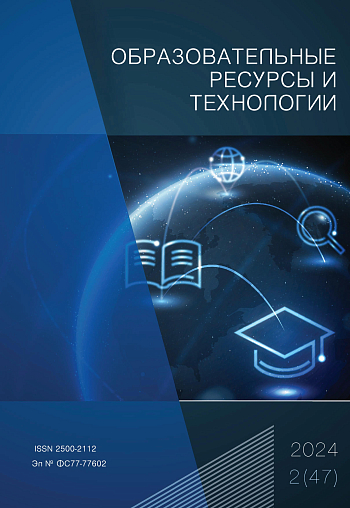Release: 2024-2 (47)

Rubrics:
Information technology
Content:
DOI: 10.21777/2500-2112-2024-2-39-47
Keywords: leadership qualities, professional development of a teacher-psychologist, development of leadership potential, psychological support of students
Annotation: The article is devoted to the development of leadership qualities of students in the psychological and pedagogical field of training in the process of studying at a university. In the process of solving professional tasks, a teacher- psychologist uses his personal resources, including the ability to motivate participants in educational relations, organize joint work, give an expert assessment and actively assist in solving pedagogical issues. The leadership potential of students can be revealed in the learning process, therefore, it is of particular importance to search in the educational space of the university for opportunities for students to form leadership competencies. The article analyzes leadership qualities as professionally significant in the activities of a teacher-psychologist. The conditions are presented in which the leadership qualities of future teachers-psychologists will be actualized and revealed, allowing students to realize their own leadership potential. Pedagogical technologies for the de- velopment of students’ leadership qualities are presented: activation of students’ problem-finding and research activities, inclusion of students in curatorial, mentoring, volunteer activities and student government activities, as well as solving practical cases with involved specialists in the field of team management. The results of the study can be used to improve the process of professional training of future educational psychologists.
THE ISSUE OF CONVERTING THE REQUIRED ADDRESS TO A STRING FORM
DOI: 10.21777/2500-2112-2024-2-65-81
Keywords: a mandatory address, a string address, an address model, a generative grammar, an equivalence criterion for sets of addresses
Annotation: The article explores the topic of formal description and normalization of the generally accepted concept of “address” in the database. The relevance of the work is due to the high degree of variability of addresses and the need to create a significant number of grammatical rules for their formal description and normalization. The article proposes an approach to summarize the rules of this description. The criterion of sets equivalence of generated address strings is formulated. A system of formal grammar rules has been developed that converts a set of address details values into a string form. The address bar is considered as a linguistic variable, the source of which is the required address, transformed according to the rules of the generative grammar. In turn, each request address is considered as the result of converting the corresponding address bar using the rules of the recognizing grammar. Using the method of logical categorization of the conversion process of a specific address, an address tree has been built, the paths of which determine the structure of each address bar. A theoretical model is proposed for the automatic conversion of a mandatory normalized address into a string form. The results obtained can be useful for designers of information systems containing address description data or interacting with them.
FUNDAMENTALS OF THE THEORY OF CORRESPONDENCE BETWEEN INFORMATION OBJECTS
DOI: 10.21777/2500-2112-2024-2-82-90
Keywords: correspondence theory, information object, information unit, implicit knowledge, relation, types of correspondences
Annotation: The article explores the category of “correspondence” in the field of information field and information modeling. The category of “correspondence” has a multifaceted nature of existence in terms of form, content, and relation- ships between objects. Correspondence can be a function, an image, a computational or logical operation, a way of transmitting information units, etc. Correspondence can be considered as a relationship, as a property between two entities, as a result of comparing information objects, as an assessment of the results of an infor- mation search. Correspondence can be procedural, semantic, morphological, structural, etc. Different types of correspondence determine the relevance of its research. The article presents a systematics of correspondences according to formal and applied features. The content of the correspondences of formal and applied meaning is revealed. Generalized properties of the category “correspondence” and its complement “nonconformity” are presented in terms of set theory and mathematical logic. The difference between full and partial correspondence is shown. It is shown that an important category of correspondence is ontological correspondence, which al- lows the formation of knowledge, and information correspondence, which is a composite correspondence in the information field. The developed foundations of the theory of correspondence between information objects are aimed at expanding and clarifying the formalized procedures of information retrieval and information modeling, and identifying implicit knowledge.
THE USE OF RECURRENT NEURAL NETWORKS TO ANALYZE TIME SERIES AND IDENTIFY TRENDS IN DATA
DOI: 10.21777/2500-2112-2024-2-91-102
Keywords: recurrent neural networks, temporal series, transformers, long-term dependencies, encoder
Annotation: Traditional models of the recurrent neural network (RNN), such as LSTM (Long Short-Term Memory) and GRU (Gated Recurrent Unit), have long been used for time series analysis, but have limitations in learning on long sequences and high computational requirements. Recent advances in time series forecasting have shown a de- crease in their importance. In this article, a new RNN architecture with linear temporal complexity and lower memory consumption is proposed. During the study, the proposed RNN model was tested and its performance was evaluated for various temporal series analysis tasks. The presented results of the experiment show that the proposed model is superior to modern alternatives. The competitiveness of the model was confirmed by comparison with advanced models such as PatchTST and TimesNet. In addition, the proposed model surpassed the perfor- mance of models based on multilayer perceptrons (MLP) and proved to be more effective than models based on transformers. The proposed RNN architecture may become a promising direction for future research in this field.
